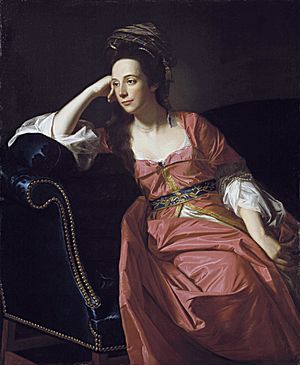Margaret Kemble Gage facts for kids
Margaret Kemble Gage (1734–1824) was an important woman during the American Revolutionary War. She was married to General Thomas Gage, who was the leader of the British Army in Massachusetts. Margaret was born in New Brunswick, Province of New Jersey, and later lived in East Brunswick Township. She passed away in England in 1824. Her family connections linked her to many important English noble families, and she had Dutch and Huguenot ancestors from the early days of America.
Quick facts for kids Margaret Kemble Gage |
|
|---|---|

Portrait of Gage in the Turquerie style, circa 1771, by John Singleton Copley. This portrait is in the Timken Museum of Art in San Diego, California.
|
|
|
|
|
| Born | 1734 New Brunswick, Province of New Jersey |
| Died | 1824 (aged 89–90) England |
| Parents |
|
| Spouse | |
| Children |
|
Margaret's Family and Life
Margaret Kemble came from a well-known family. Her father, Peter Kemble, was a successful businessman and politician in New Jersey. Her mother was Gertrude Bayard. This meant Margaret was the granddaughter of Judge Samuel Bayard and Margaretta Van Cortlandt. Her great-grandparents included Mayor of New York City Stephanus Van Cortlandt and Gertrude Schuyler.
Margaret married Thomas Gage on December 8, 1758. Their wedding took place at her father's large plantation in New Jersey. Years later, during the harsh winter of 1779–80, generals from the Continental Army stayed at this same plantation.
After the American Revolution began, Margaret Kemble Gage sailed to England in the summer of 1776. She was on a ship carrying soldiers wounded at the Battle of Bunker Hill, along with military widows and orphans. Her husband, General Gage, joined her a few months later. He had been called back to England because his efforts to solve the problems with the colonists had failed. Margaret and Thomas settled in London with their eleven children.
Margaret lived 36 years longer than her husband. Their first son, who would become the 3rd Viscount Gage, was born in 1761. Margaret's daughter, Charlotte Margaret Gage, married Admiral Sir Charles Ogle.
Margaret's brother, Stephen Kemble, was a lieutenant-colonel in the British Army during the Revolution. Margaret was also portrayed by Emily Berrington in the TV show Sons of Liberty.
Did Margaret Help Start the Revolution?
Some historians believe that Margaret Kemble Gage might have played a role in the very first shots of the American Revolution. This happened at the Battle of Lexington and Concord.
In the days before this battle, the Sons of Liberty in Boston noticed that British troops were getting ready for something big. Dr. Joseph Warren, a key leader of the Sons of Liberty, had a secret helper. This helper was very close to the British leaders. This secret source gave Warren important information. The information was about the British plan to arrest Samuel Adams and John Hancock in Lexington. It also revealed their plan to burn the colonists' military supplies in Concord.
General Gage had hoped to avoid a war. He planned a secret night march. He wanted to move Adams and Hancock, and the colonial powder and cannons, while everyone slept.
But Dr. Warren learned of the plan. He quickly sent Paul Revere and William Dawes to spread the alarm. They set off a chain reaction of riders across Massachusetts and even to other colonies. Instead of a quiet night mission, the British troops found thousands of angry, armed colonists waiting for them.
By the end of that day, the British troops were under heavy attack. If General Gage had not sent 1,000 more soldiers with cannons, the first 700 British troops might not have made it back to Boston.
No one knows for sure who Dr. Warren's secret source was. He kept it a secret and was killed two months later at the Battle of Bunker Hill.
The evidence is not strong, but many historians think Margaret Kemble Gage was the secret source. She was an American from a very rich and respected family. Her social standing was equal to her husband's. General Gage's officers even called her "Dutchess." She openly showed that she had mixed feelings about the war. She said she hoped her husband would "never be the instrument of sacrificing the lives of her countrymen."
General Gage himself said he had told only two people about his secret plan. One was his second-in-command, and the other was a mystery person. Some other top British officers suspected that this mystery person was General Gage's wife.
Before the battles of Lexington and Concord, General Gage was very devoted to his wife. But after the unexpected fighting, he ordered her to leave him. He put her on a ship back to England.

